One of the lesser known benefits of resistance training is the huge benefits it has for bone health. While the best way to set yourself or your child up for success is physical activity throughout the lifespan (especially in the bone growing years), resistance training can also play a tremendous role in strengthening our bones.

Our bones, much like the rest of our body respond to the stresses we place upon it. This is why when we lift heavy loads or resistance train our neuromuscular system responds to this stressor (resistance training) by building stronger musculature and supporting structures. This is the basis of all training, the body adapts to the demands we place upon it, and if we stop progressing the training stimulus, our body does not adapt and we plateau, or don’t further increase our strength.
Bone responds very similarly to resistance training and progressive overload (while the cycle is much longer), studies have shown improvements in bone mineral density (BMD) (a key marker in bone health) in as little as 16 weeks of a resistance training program in elderly adults.
As we know osteoporosis and osteopenia are huge issues that aging individuals experience (especially in post-menopausal women), where the risk of fractures can significantly impact an individual’s activities of daily living. While the best way to combat this is to build strong bones in our youth, a recent meta-analysis has also shown that resistance training in post-menopausal women is effective in increasing BMD in the femoral neck and lumbar spine (Zhao & Xu 2015), two common areas of fracture in elderly women.
While nutrition also plays a key role in setting us up for great bone health, resistance training in youth, but also as we age is extremely important to live a long, healthy and functional life!
Email Bskinner@sstcanada.com to get more information to work with one of our coaches to help you progress your training, maximize your functional abilities, and get SST strong!
Reference:
Zhao, R., Zhao, M. & Xu, Z.
Osteoporos Int (2015) 26: 1605. https://doi.org/10.1007/s00198-015-3034-0



